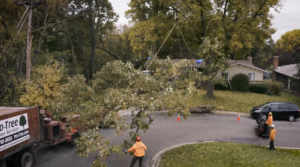There are an estimated one billion ash trees in Minnesota; the largest population of any state. Ash trees are a native species, though many were also planted in urban and suburban settings in the Twin Cities metro because they offer shade, privacy, and beauty while being able to tolerate Minnesota’s harsh winter climate.
 Unfortunately, many ash trees in Minnesota have recently fallen victim to something they can’t tolerate: emerald ash borers (EAB). These invasive beetles arrived in Minnesota during the last twenty years and in that time they’ve already killed countless ash trees throughout the state. If an ash tree is dying because of an EAB infestation or any other cause, there will be some apparent signs. Continue reading to learn how you can recognize if your ash tree is dead or soon will be.
Unfortunately, many ash trees in Minnesota have recently fallen victim to something they can’t tolerate: emerald ash borers (EAB). These invasive beetles arrived in Minnesota during the last twenty years and in that time they’ve already killed countless ash trees throughout the state. If an ash tree is dying because of an EAB infestation or any other cause, there will be some apparent signs. Continue reading to learn how you can recognize if your ash tree is dead or soon will be.
4 Signs of a Dying Ash Tree
1. Sparse Crown
The crown of an ash tree should have thick foliage. If the crown is thin and it looks like few or no new leaves are growing, this is a clear sign that your ash tree is dying and likely has been infested by emerald ash borers. EAB larvae destroy an ash tree’s vascular system with their boring, which results in crown dieback and eventually leads to the death of the tree itself. While an EAB infestation is the most likely cause of a sparse crown, other culprits could be poor soil quality, lack of sunlight or chemical trespass.
2. Cracking Bark
A common sign of a dying ash tree is the bark beginning to crack and split off from the trunk of the tree. Whenever bark starts falling from a tree, it’s a clear sign of a serious health problem, usually disease, pest infestation or internal damage. In the case of ash trees in Minnesota, cracking bark is most likely the result of emerald ash borer infestation. As the bark falls off, you may be able to see the winding galleries that are built by EAB larvae as they bore through the tree.
3. EAB Exit Holes
A telltale sign that your ash tree is dying because of emerald ash borers is finding D-shaped holes on the trunk of your tree. These exit holes are created when emerald ash borers mature to adulthood and bore their way out of the ash tree. Exit holes are only about ⅛ inch in diameter, so you’ll need to inspect your tree trunk closely to see them. If you discover these EAB exit holes, your ash tree is most likely either already dead or will die soon.
4. Blonding by Woodpeckers
If woodpeckers seem to be flocking to your ash tree in Minnesota, the tree is most likely dying of an EAB infestation. Native woodpeckers feed on EAB larvae and tend to congregate on trees that have been invaded by emerald ash borers. Woodpecker damage to ash trees results in the dark outer layer of bark being stripped away, revealing lighter bark beneath; this is known as “blonding.” When woodpeckers begin blonding an ash tree on your property, it’s a good time to call a tree removal company in the Twin Cities.
Dead Ash Tree? Call a Tree Removal Company in the Twin Cities
When your ash tree is dead or dying because of an EAB infestation, it’s in your best interest – and the community’s – to have it professionally removed before the tree becomes a hazard or the pests spread. Contact Pro Tree today if you need EAB prevention treatments or ash tree removal services in the greater Twin Cities metro area!


Write a Comment